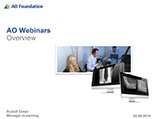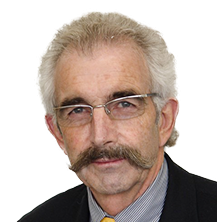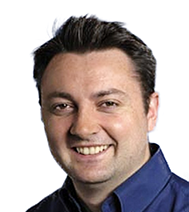AO Webinars: learning and discussing with experts wherever you are
Learn from world-renowned experts and discuss “hot” clinical topics in real time through AO Webinars.
Read an interview with Professor Jörg Auer
Explore Diarmuid de Faoite's experience as a webinar moderator
_________________________________
What is a webinar?
A webinar is an interactive presentation on the internet. The transmission of information works two ways—enabling the audience to ask questions and receive answers in real time. Because webinars are live, they require participants to attend at a specific date and time. Recordings of live webinars can be viewed at a later date, however.
What makes webinars popular with AO surgeons?
Webinars are a popular learning tool because they are interactive and can incorporate videos, PowerPoint slides, and other media. They can be viewed from anywhere in the world. With several hundreds of participants, webinars easily reach more learners than face-to-face meetings. The versatility of viewing options (computer, tablet, or smart phone) as well as the option to view a webinar either live, or a recording at a later date, make webinars a first-choice learning method for anyone with a busy schedule.
AO Foundation webinars
AOTrauma was the first clinical division (CD) to conduct webinars, with Christoph Sommer presenting on pilon fractures in 2010. Since then, the number of AO webinars has grown exponentially. Today, AO hosts about 40 webinars per year from the AO Education Institute (AOEI) in Dübendorf, Switzerland. More webinars in local languages are hosted by the AO regions.
AOEI has designed a standard webinar structure, consisting of a 40-minute presentation followed by a Q&A session to finish-out the hour. Typically, the webinars consist of one surgeon presenting, but expert discussions with up to four presenters have also been held.
Diverse topics across all clinical divisions
Webinar topics are decided upon by the individual CDs. AO webinars are scheduled throughout the year. They are announced via the respective CD’s website and through email updates. AO webinars are free of charge with members receiving the login information after registration. For those who cannot attend the live session, the webinars can be viewed online in the webinar and webcast library.
The future of webinars
AO strives to make webinars more user-friendly, accessible, and deliverable from any location around the globe. This requires technical know-how as well as content and videography standardizations. To learn more, visit the AO Foundation webinar and webcast page.
Specialists assisting with your webinar
Diverse, evolving topics
Topics for webinars are decided by the CDs and scheduled throughout the year. Each CD announces webinars on their individual website and through email updates. When members register for a webinar they are provided with the log in information.
Webinars are free, but there is a limit to the number of people who can view a live webinar (usually around 250). For those who cannot make the live session, all webinars are also available online in the webinar and webcast library.
The future of webinars
AO is striving to make webinars more accessible to more learners in more places. AOEI is constantly refining the technology to make webinars more user friendly and globally functional. The goal is to have webinars be viewable and deliverable from any location. While this takes some technical know-how, it also entails standards for content and videography. To find out more about AO webinars, please visit the AO Foundation webinar and webcast page.
Webinars in numbers:
40
Number of webinars the AO Education Institute hosts each year
250
Target number of webinar participants
 "A great tool to reach out to people from all parts of the world."
"A great tool to reach out to people from all parts of the world."
Professor Jörg Auer, Chair of the AOVET International Board, shares some personal tips on how to make your webinar successful.
How was the webinar you moderated received by its audience?
Really well. People from all over the world attended—from Russia, Japan, Australia, India, Brazil, the USA, and Costa Rica. It is exciting to be speaking live to people from so many different countries. A webinar is a great tool to reach out to people from all parts of the world.
What is the key element of a good webinar?
It is the same as for a good lecture—preparation. AO provides professional support for webinars, making it easy for the presenter and the moderator to do their jobs. One of the most important points is the rehearsal shortly before the live webinar. This helps to eliminate technical mistakes, and can enhance the surgeon’s presentation.
How is it different from a regular lecture?
The most distinguishing feature is the lack of a visible audience. You speak to a camera, and participant interactivity is limited to a few questions and answers. You have no idea whether your participants are actually interested or fast asleep.
How do you deal with this?
I ignore the thought of sleeping participants and focus on my competence. The best webinars are those delivered by confident, knowledgeable lecturers, who captivate their audience when transferring knowledge.
___________
ABOUT Jörg Auer Dr. med. vet. MS
Jörg Auer is the chairperson of the AOVET International Board. He spent his early career in the United States at the Department of Large Animals Medicine and Surgery at Texas A&M (Agricultural and Mechanical) University. Jörg Auer was recently the moderator of the Webinar "Fracture Management of the Head Region; Part II: Head and Skull—What can be done?"
 Moderator Diarmuid De Faoite shares the challenges of being the man in the background
Moderator Diarmuid De Faoite shares the challenges of being the man in the background
When I was asked to comoderate the webinar, I was excited to be involved in a new experience. After all, I was not going to be the one the camera was on, how hard could it be? The answer was: very hard indeed!
I was lulled into a false sense of security in the run-throughs, because it was impossible to replicate the real-time experience of questions whizzing in from all around the world. In the practice runs, I simply posed the presenter a few questions I had prepared myself. During the live webinar, I asked people to send in their questions, but they came in only in drips and drabs. With the benefit of hindsight, I know this was because they were too engrossed in the presentation to chat with me.
During the webinar itself, I was rather nervous. Did I send my message to the right person? Did I manage to send a reminder to everyone to send in their questions?
However, once the Q&A session began, I suffered from question overload. The chat window began to fill up quickly, as the questions whipped in from across the globe. I had little time to reflect on each one. I quickly had to evaluate whether the question had already been covered or was appropriate for the webinar (some questions were too specific. I asked these people to contact us after the webinar). In addition, since English was not the first language of many of the participants and they were typing quickly, I also had to make some fast edits, in order to make the questions as easy to understand as possible for the presenter.
Having worked in radio, I know that the worst possible thing is “dead air” or time when nothing is being said. I kept feeding the presenter with questions to avoid this, plus I made sure to offer her a choice of questions so that she could pick the one she felt most comfortable with. Obviously, the person giving the webinar is under the most pressure and the support team should be there to reduce any additional stress.
Based upon my experiences over the two days, organizing and giving a webinar involves a steep learning curve for everyone doing it for the first time–even for the moderator in the background.
Further information
Discover the upcoming AOTrauma online learning opportunities or search for the recorded events on the webinar and webcast library.
AOTrauma
www.aotrauma.com | education@aotrauma.org
Copyright © 2015 AO Foundation. All rights reserved.


